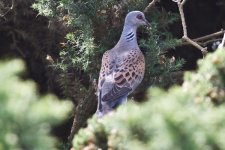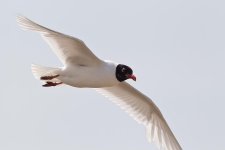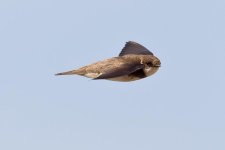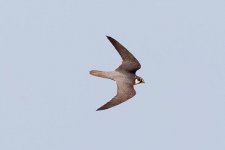-
Welcome to BirdForum, the internet's largest birding community with thousands of members from all over the world. The forums are dedicated to wild birds, birding, binoculars and equipment and all that goes with it.
Please register for an account to take part in the discussions in the forum, post your pictures in the gallery and more.
You are using an out of date browser. It may not display this or other websites correctly.
You should upgrade or use an alternative browser.
You should upgrade or use an alternative browser.
Norfolk birding (20 Viewers)
- Thread starter Edward woodwood
- Start date
More options
Who Replied?First of all, apologies for not posting this much sooner after the event so others who might have felt inclined could have followed it up, but other important matters have kept me preoccupied over the past couple of days.
Late Wednesday afternoon my wife and I went for a walk on the open ground east of Beeston Bump (anyone know if this area has a name?). We were at the seaward end of the path that runs along the hedge that forms the boundary with the adjacent caravan site. I heard a song which at first made me think of Song Thrush, but I immediately realized it didn't sound right - and certainly not coming from the middle of a dense bramble thicket!
It continued with a few intermittent bursts, some quite repetitive, and including some very rich notes. It soon stopped completely, and I couldn't see it despite waiting a while. My first thought was Marsh Warbler, and listening to recordings on xeno-canto.org lends weight to that. The last one I heard was the bird at Weybourne at the same time as the singing male Rosefinch a good few years ago.
Any thoughts as to the likelihood of this - or otherwise?
Apologies again for late report.
Nigel
Late Wednesday afternoon my wife and I went for a walk on the open ground east of Beeston Bump (anyone know if this area has a name?). We were at the seaward end of the path that runs along the hedge that forms the boundary with the adjacent caravan site. I heard a song which at first made me think of Song Thrush, but I immediately realized it didn't sound right - and certainly not coming from the middle of a dense bramble thicket!
It continued with a few intermittent bursts, some quite repetitive, and including some very rich notes. It soon stopped completely, and I couldn't see it despite waiting a while. My first thought was Marsh Warbler, and listening to recordings on xeno-canto.org lends weight to that. The last one I heard was the bird at Weybourne at the same time as the singing male Rosefinch a good few years ago.
Any thoughts as to the likelihood of this - or otherwise?
Apologies again for late report.
Nigel
Last edited:
Penny Clarke
Well-known member
Arctic Skua flying west from end of East Bank, Cley. 8 Spoonbills and a Yellow Wagtail on the Serpentine. 3 Silver Washed Fritillaries and a White Admiral at Holt Country Park. Little Gull this evening from Daukes Hide, Cley NWT.
Full update on blog
Penny:girl:
Full update on blog
Penny:girl:
upstarts1979
Well-known member
Also, at least (!) nine Little Ringed Plover chicks have hatched from three or four pairs (the doubt comes from the time between young at one site - do Little Ringed Plovers have two broods?), four of which have now taken flight.
Yes they do have 2 broods as witnessed at my local patch at upton warren worcs :t:
Stratton Birder
Well-known member
First of all, apologies for not posting this much sooner after the event so others who might have felt inclined could have followed it up, but other important matters have kept me preoccupied over the past couple of days.
Late Wednesday afternoon my wife and I went for a walk on the open ground east of Beeston Bump (anyone know if this area has a name?). We were at the seaward end of the path that runs along the hedge that forms the boundary with the adjacent caravan site. I heard a song which at first made me think of Song Thrush, but I immediately realized it didn't sound right - and certainly not coming from the middle of a dense bramble thicket!
It continued with a few intermittent bursts, some quite repetitive, and including some very rich notes. It soon stopped completely, and I couldn't see it despite waiting a while. My first thought was Marsh Warbler, and listening to recordings on xeno-canto.org lends weight to that. The last one I heard was the bird at Weybourne at the same time as the singing male Rosefinch a good few years ago.
Any thoughts as to the likelihood of this - or otherwise?
Apologies again for late report.
Nigel
Difficult to comment on your bird without hearing the song but this date is a bit late for a singing Marsh Warbler - June is the best month to find one of these - but you sound reasonably confident. All the singing Marsh Warblers I've recorded have been from lusher, damper areas than where this one was although I wouldn't rule out this habitat completely when you're talking about wandering birds from the continent. Was there any mimickry in the song? When in full swing, Marsh Warblers are renowned for their skill at imitating common species which often include Swallow, House Sparrow, Linnet, Chiffchaff and Willow Warbler. Apparently, females sing too, although not as strongly as males.
At this time of year its also worth bearing in mind that many common species will go into sub-song and skulk. Sometimes they will sound completely unfamiliar. I once spent a long time following up an unusual song and scrutinising a single bush to eventually find a Blackbird staring back at me! Its a shame you couldn't get the news out on the day. Good luck if you decide to submit it.
Stratton Birder
Well-known member
My first leisurely seawatch of the summer/autumn was fairly productive for a couple of hours viewing off Winterton, first thing this morning. Two close in Arctic Skuas were the highlight but I was also pleased with the amount of over-summering or early returning Common Scoters off here which totalled 280. 10 Teal flew north accompanied by a single Shoveler and a few Dunlin, Bar-tailed Godwits and Ringed Plover passed in both directions. A lone Whimbrel flew in off the sea, carried on strongly inland and looked bound for Hickling or Horsey. Lastly, there was a feeding frenzy some distance offshore which included 12 Gannets and two Harbour Porpoises.
Difficult to comment on your bird without hearing the song but this date is a bit late for a singing Marsh Warbler - June is the best month to find one of these - but you sound reasonably confident. All the singing Marsh Warblers I've recorded have been from lusher, damper areas than where this one was although I wouldn't rule out this habitat completely when you're talking about wandering birds from the continent. Was there any mimickry in the song? When in full swing, Marsh Warblers are renowned for their skill at imitating common species which often include Swallow, House Sparrow, Linnet, Chiffchaff and Willow Warbler. Apparently, females sing too, although not as strongly as males.
At this time of year its also worth bearing in mind that many common species will go into sub-song and skulk. Sometimes they will sound completely unfamiliar. I once spent a long time following up an unusual song and scrutinising a single bush to eventually find a Blackbird staring back at me! Its a shame you couldn't get the news out on the day. Good luck if you decide to submit it.
Thanks for taking the time to comment on this, Stratton Birder - and for your helpful thoughts. Unfortunately the singing did not continue for very long so this one will go down only as a 'possible'. Thanks again.
Titchwell July 15th
Today’s highlights
Spoonbill – 9 on fresh marsh all day
Spotted redshank – 7 on fresh marsh
Red kite – 1 west @ 11:30
Little gull – 7 on fresh marsh
Greenshank – 1 on fresh marsh
Dunlin – 54 on fresh marsh
Avocet – 204 on fresh marsh
Knot – 2500 roosting on fresh marsh
Paul
Today’s highlights
Spoonbill – 9 on fresh marsh all day
Spotted redshank – 7 on fresh marsh
Red kite – 1 west @ 11:30
Little gull – 7 on fresh marsh
Greenshank – 1 on fresh marsh
Dunlin – 54 on fresh marsh
Avocet – 204 on fresh marsh
Knot – 2500 roosting on fresh marsh
Paul
Penny Clarke
Well-known member
Two Eagle Owls and two Parrots in King's Lynn :t:
:t:
Penny:girl:
Penny:girl:
Michael Stowers
Well-known member
Apparently ravens in K. Lynn too!!! According to Lynn News!!
David Norgate
Well-known member
Apparently ravens in K. Lynn too!!! According to Lynn News!!
Now that's slightly more interesting (or probably not!)
What's Lynn News say about them?!?
Titchwell July 16th
Today’s highlights
Spoonbill – 13 on fresh marsh
Dunlin – 70 on fresh marsh
Spotted redshank – 4 on fresh marsh
Ruff – 4 on fresh marsh
Little gull – 5 on fresh marsh
Greenshank – 5 on fresh marsh
Golden plover – 4 on fresh marsh
Knot – 2000 roosting
Paul
Today’s highlights
Spoonbill – 13 on fresh marsh
Dunlin – 70 on fresh marsh
Spotted redshank – 4 on fresh marsh
Ruff – 4 on fresh marsh
Little gull – 5 on fresh marsh
Greenshank – 5 on fresh marsh
Golden plover – 4 on fresh marsh
Knot – 2000 roosting
Paul
Michael Stowers
Well-known member
Don't get too excited - read carefully!
http://www.lynnnews.co.uk/news/loca...-causing-some-fear-among-pet-owners-1-5270007
http://www.lynnnews.co.uk/news/loca...-causing-some-fear-among-pet-owners-1-5270007
Penny Clarke
Well-known member
Yes, I did notice the mention of ravens and smiledDon't get too excited - read carefully!
http://www.lynnnews.co.uk/news/loca...-causing-some-fear-among-pet-owners-1-5270007
Penny:girl:
Michael Stowers
Well-known member
Does anyone have any info on how Dartford warblers have faired in East Anglia this year after the severe winter we just experienced?
David Norgate
Well-known member
Don't get too excited - read carefully!
http://www.lynnnews.co.uk/news/loca...-causing-some-fear-among-pet-owners-1-5270007
.. and I thought Ravens were black birds!:eat:
john miller
Well-known member
Still at least one Turtle Dove on Kelling Heath, Med Gull Salthouse beach car park feeding with the Black-headed, plus a Hobby had one of the many breeding Sand Martins at Gramborough Hill for its supper.
www.kellingnature.zenfolio.com
www.kellingnature.zenfolio.com
Attachments
Norfolk Snake
Well-known member
Not bird related but for other naturalists, Holkham particularly good at moment - lots of Dark Green Fritillaries on dunes, White Admirals , White - letter Hairstreaks, Broad - bordered Bee Hawkmoths and Hornet moths all out and about from Lady Anne's Drive west.
Users who are viewing this thread
Total: 21 (members: 0, guests: 21)







